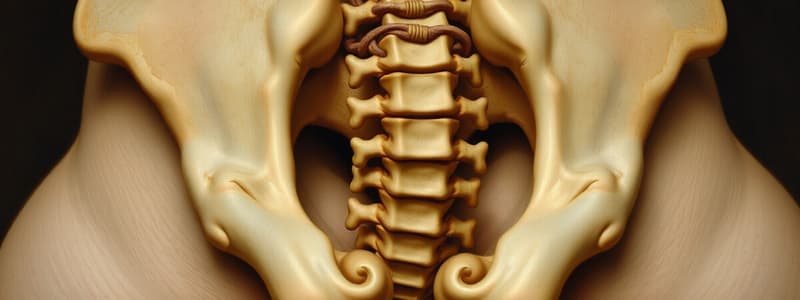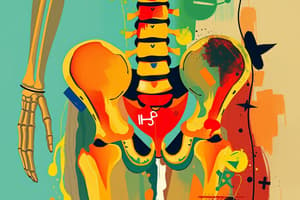Podcast
Questions and Answers
What percentage of pelvic injuries occur in men?
What percentage of pelvic injuries occur in men?
- 50%
- 75% (correct)
- 65%
- 80%
Which mechanism of injury is NOT commonly associated with pelvic injuries?
Which mechanism of injury is NOT commonly associated with pelvic injuries?
- Crush injury
- High energy transfer e.g. RTC
- Direct blow to the pelvis (correct)
- Fall from height
What is the leading cause of death in patients suffering from pelvic trauma?
What is the leading cause of death in patients suffering from pelvic trauma?
- Haemorrhage (correct)
- Infection
- Pulmonary embolism
- Post-operative complications
In which context are pelvic fractures most commonly occurring?
In which context are pelvic fractures most commonly occurring?
Which of the following injuries is a potential complication of pelvic fractures?
Which of the following injuries is a potential complication of pelvic fractures?
Which of the following is a risk factor that can contribute to pelvic injuries from simple falls?
Which of the following is a risk factor that can contribute to pelvic injuries from simple falls?
What effect does a pelvic fracture have on pelvic volume?
What effect does a pelvic fracture have on pelvic volume?
Which of the following is a common distracting injury that may accompany pelvic injuries?
Which of the following is a common distracting injury that may accompany pelvic injuries?
Which symptom is NOT associated with pelvic injuries?
Which symptom is NOT associated with pelvic injuries?
What is the primary goal of management for patients with pelvic injuries?
What is the primary goal of management for patients with pelvic injuries?
Which of the following actions should be avoided when treating pelvic injuries?
Which of the following actions should be avoided when treating pelvic injuries?
What should be done once a pelvic splint is applied?
What should be done once a pelvic splint is applied?
What is the recommended method for transporting a patient with a pelvic injury?
What is the recommended method for transporting a patient with a pelvic injury?
The pelvic splint is designed to be
The pelvic splint is designed to be
In pelvic injury management, what is the purpose of high-flow oxygen?
In pelvic injury management, what is the purpose of high-flow oxygen?
Which factor is essential when considering the mechanism of injury in pelvic injuries?
Which factor is essential when considering the mechanism of injury in pelvic injuries?
What is the percentage of spinal injuries attributed to falls?
What is the percentage of spinal injuries attributed to falls?
Which mechanism of injury is NOT typically associated with spinal injuries?
Which mechanism of injury is NOT typically associated with spinal injuries?
Which type of spinal injury involves the displacement of vertebrae?
Which type of spinal injury involves the displacement of vertebrae?
What complication occurs as a complete loss of motor function following spinal cord injury?
What complication occurs as a complete loss of motor function following spinal cord injury?
Which condition signifies severe compression or inflammation of spinal nerves in the lowest region of the spinal canal?
Which condition signifies severe compression or inflammation of spinal nerves in the lowest region of the spinal canal?
Which of the following is a common sign of spinal injury?
Which of the following is a common sign of spinal injury?
What can cause neurogenic shock following a spinal cord injury?
What can cause neurogenic shock following a spinal cord injury?
Which phases may signal the onset of cauda equina syndrome?
Which phases may signal the onset of cauda equina syndrome?
Which of these symptoms is NOT typically associated with spinal cord injuries?
Which of these symptoms is NOT typically associated with spinal cord injuries?
What percentage of spinal injuries result from road traffic collisions?
What percentage of spinal injuries result from road traffic collisions?
What is a common cause of spinal injuries other than trauma?
What is a common cause of spinal injuries other than trauma?
Which structure is primarily affected by a bulging disc?
Which structure is primarily affected by a bulging disc?
Which injury mechanism is characterized by excessive bending of the spine?
Which injury mechanism is characterized by excessive bending of the spine?
Which symptom may indicate lower limb weakness related to spinal injury?
Which symptom may indicate lower limb weakness related to spinal injury?
Flashcards are hidden until you start studying
Study Notes
Pelvic Injuries
- Pelvic fractures account for approximately 3-6% of adult fractures.
- Occurrences of pelvic injuries are present in 20% of all polytrauma cases.
- 75% of pelvic injury cases involve males.
- Haemorrhage is the leading cause of death in 40% of patients with pelvic trauma.
Causes of Pelvic Injuries
- Significant high-energy transfers, such as road traffic collisions (RTCs).
- Falls from heights and crush injuries are also common causes.
- Simple falls can cause pelvic injuries, particularly in high-risk groups like the elderly and those with degenerative bone diseases or undergoing radiotherapy.
Complications from Pelvic Injuries
- Increased pelvic volume from fractures can lead to severe haemorrhage.
- Vascular injuries may occur, causing further bleeding.
- Urogenital injuries, such as bladder ruptures, arise in about 10% of cases.
- Patients may present with other serious injuries, including intra-thoracic or intra-abdominal damage.
Signs & Symptoms of Pelvic Injuries
- Common signs include bruising, swelling, and deformity.
- May experience bleeding from the rectum, vagina, or urethra.
- Signs of hypovolemic shock and altered sensation in limbs are critical indicators.
- Characteristic pain is felt in the hips, groin, or lower back.
Management of Pelvic Injuries
- Follow JRCALC guidelines emphasizing DRABC (Danger, Response, Airway, Breathing, Circulation).
- Immediate immobilization is vital, including using pelvic splints to stabilize.
- Control catastrophic haemorrhage and ensure high-flow oxygen delivery.
- Do not remove a pelvic splint once applied, to avoid exacerbating injuries.
- Minimize movement and avoid repeated examinations.
Pelvic Splint Information
- Pelvic splints are single-use devices designed to fit a range of patients from pediatric to bariatric sizes.
- Essential for immediate stabilization during transport to a major trauma center (MTC).
Spinal Injuries
- Common mechanisms include hyperflexion, hyperextension, rotation, and compression.
- Falls account for approximately 46% of spinal injuries, with many occurring from heights under 2 meters.
- Road traffic collisions contribute to 40% of spinal injuries, with 3% from sports activities.
Types of Spinal Injuries
- Dislocation, fracture, or displacement of vertebrae can lead to spinal cord injury (SCI) due to compression or stretching of the cord.
Complications Associated with Spinal Injuries
- Can result in spinal cord damage, spinal shock, neurogenic shock, respiratory complications, and cauda equina syndrome.
- Spinal shock presents as loss of motor and possibly sensory function, with lengthy recovery potential.
- Neurogenic shock leads to impaired tissue perfusion from loss of sympathetic tone.
Clinical Signs of Spinal Injury
- Presenting symptoms include pain along the spine, loss of limb sensation or movement, and altered trunk sensation.
- Hypotension may also be a significant indicator of severity.
Cauda Equina Syndrome
- Results from severe compression or inflammation of lower spinal nerves.
- Can manifest acutely or chronically and requires urgent surgical intervention for decompression.
- Significant clinical red flags include saddle anesthesia, bladder/bowel dysfunction, and lower limb weakness.
Summary
- Pelvic injuries pose a high risk of fatal haemorrhage; immediate splinting and careful transport are essential.
- Spinal injuries require acute recognition and management to prevent irreversible damage and complications.
Studying That Suits You
Use AI to generate personalized quizzes and flashcards to suit your learning preferences.




